| Weight | 1 lbs |
|---|---|
| Dimensions | 9 × 5 × 2 in |
| host | mouse |
| isotype | IgG1 |
| clonality | monoclonal |
| concentration | concentrate, predilute |
| applications | IHC |
| reactivity | human |
| available size | 0.1 mL, 0.5 mL, 1 mL concentrated, 7 mL prediluted |
mouse anti-CD21 monoclonal antibody (ZM75) 6076
Price range: $160.00 through $528.00
Antibody summary
- Mouse monoclonal to CD21
- Suitable for: Immunohistochemistry (formalin-fixed, paraffin-embedded tissues)
- Reacts with: Human
- Isotype:IgG1
- Control: Tonsil, lymph node
- Visualization: Cell membrane
- 0.1, 0.5, 1.0 mL concentrated, 7 mL prediluted
mouse anti-CD21 monoclonal antibody ZM75 6076
| target relevance |
|---|
| Protein names Complement receptor type 2 (Cr2) (Complement C3d receptor) (Epstein-Barr virus receptor) (EBV receptor) (CD antigen CD21) |
| Gene names CR2,CR2 C3DR |
| Protein family Receptors of complement activation (RCA) family |
| Mass 112916Da |
| Function FUNCTION: Serves as a receptor for various ligands including complement component CD3d, HNRNPU OR IFNA1 (PubMed:1849076, PubMed:21527715, PubMed:7753047). When C3d is bound to antigens, attaches to C3d on B-cell surface and thereby facilitates the recognition and uptake of antigens by B-cells (PubMed:21527715). This interaction enhances B-cell activation and subsequent immune responses. Forms a complex with several partners on the surface of B-cells including CD19, FCRL5 and CD81, to form the B-cell coreceptor complex that plays a crucial role in B-cell activation and signaling (PubMed:1383329, PubMed:30107486). Also induces specific intracellular signaling separately from the BCR and CD19 by activating the tyrosine kinase SRC, which then phosphorylates nucleolin/NCL and triggers AKT and GSK3 kinase activities in a SYK/CD19-independent manner (PubMed:12938232). Acts as a ligand for CD23 (FcepsilonRII), a low-affinity receptor for IgE, which is expressed on B-cells and other immune cells, and thus participates in the regulation of IgE production (PubMed:1386409). {ECO:0000269|PubMed:12938232, ECO:0000269|PubMed:1383329, ECO:0000269|PubMed:1386409, ECO:0000269|PubMed:1849076, ECO:0000269|PubMed:21527715, ECO:0000269|PubMed:30107486, ECO:0000269|PubMed:7753047}.; FUNCTION: (Microbial infection) Acts as a receptor for Epstein-Barr virus. {ECO:0000269|PubMed:2460635}. |
| Subellular location SUBCELLULAR LOCATION: Cell membrane {ECO:0000269|PubMed:1383329, ECO:0000269|PubMed:1702139}; Single-pass type I membrane protein. |
| Tissues TISSUE SPECIFICITY: Mature B-lymphocytes, T-lymphocytes, pharyngeal epithelial cells, astrocytes and follicular dendritic cells of the spleen. |
| Structure SUBUNIT: Interacts (via Sushi domain 1 and 2) with C3 (PubMed:11387479, PubMed:21527715). Interacts with CD19 (PubMed:1702139). Part of a complex composed of CD19, CR2/CD21, CD81 and IFITM1/CD225 in the membrane of mature B-cells (PubMed:1383329). Interacts (via Sushi domain 1 and 2) with FCER2 (via the C-terminus). Interacts with CD23 (PubMed:1386409). Interacts with FCRL5 (PubMed:30107486). Interacts with CR1 (PubMed:1708808). Interacts with INFNA1 (PubMed:1849076). {ECO:0000269|PubMed:11387479, ECO:0000269|PubMed:1383329, ECO:0000269|PubMed:1386409, ECO:0000269|PubMed:16172256, ECO:0000269|PubMed:1702139, ECO:0000269|PubMed:1708808, ECO:0000269|PubMed:1849076, ECO:0000269|PubMed:21527715, ECO:0000269|PubMed:30107486}.; SUBUNIT: (Microbial infection) Interacts with Epstein-Barr virus gp350 protein. {ECO:0000269|PubMed:2460635}. |
| Involvement in disease DISEASE: Systemic lupus erythematosus 9 (SLEB9) [MIM:610927]: A chronic, relapsing, inflammatory, and often febrile multisystemic disorder of connective tissue, characterized principally by involvement of the skin, joints, kidneys and serosal membranes. It is of unknown etiology, but is thought to represent a failure of the regulatory mechanisms of the autoimmune system. The disease is marked by a wide range of system dysfunctions, an elevated erythrocyte sedimentation rate, and the formation of LE cells in the blood or bone marrow. {ECO:0000269|PubMed:17360460}. Note=Disease susceptibility is associated with variants affecting the gene represented in this entry.; DISEASE: Immunodeficiency, common variable, 7 (CVID7) [MIM:614699]: A primary immunodeficiency characterized by antibody deficiency, hypogammaglobulinemia, recurrent bacterial infections and an inability to mount an antibody response to antigen. The defect results from a failure of B-cell differentiation and impaired secretion of immunoglobulins; the numbers of circulating B-cells is usually in the normal range, but can be low. {ECO:0000269|PubMed:22035880}. Note=The disease is caused by variants affecting the gene represented in this entry. |
| Target Relevance information above includes information from UniProt accession: P20023 |
| The UniProt Consortium |
Data
 |
| Human tonsil stained with anti-CD21 antibodyusing peroxidase-conjugate and DAB chromogen. Note the membrane staining of follicular dendritic cells in follicles. |
Publications
| pmid | title | authors | citation |
|---|---|---|---|
| We haven't added any publications to our database yet. | |||
Protocols
| relevant to this product |
|---|
| IHC |
Documents
| # | SDS | Certificate | |
|---|---|---|---|
| Please enter your product and batch number here to retrieve product datasheet, SDS, and QC information. | |||
Only logged in customers who have purchased this product may leave a review.
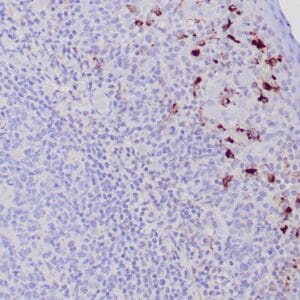
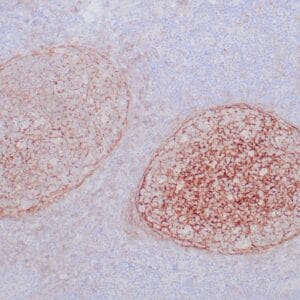
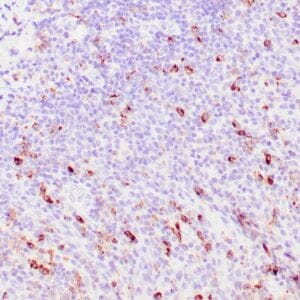

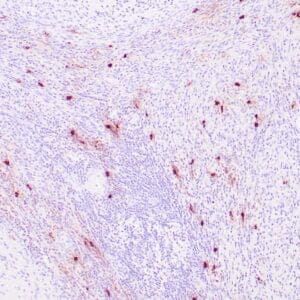

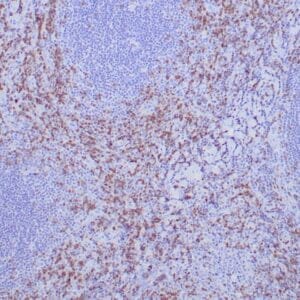

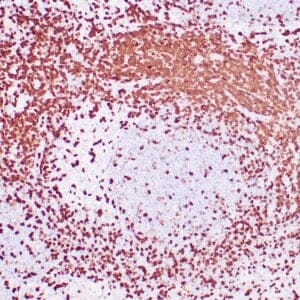
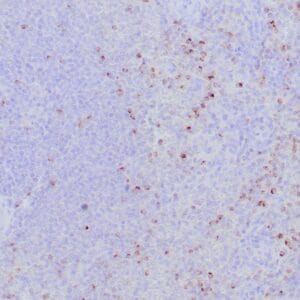
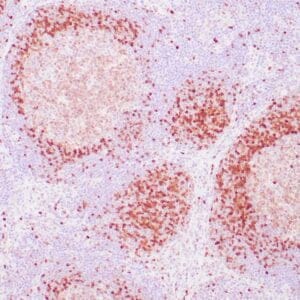
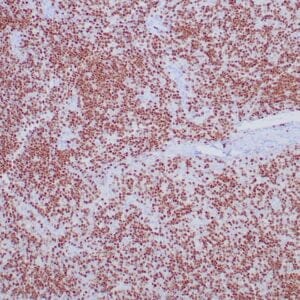
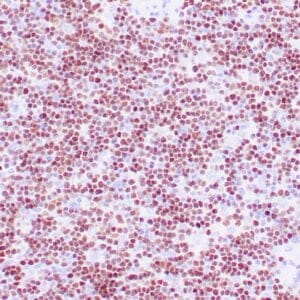
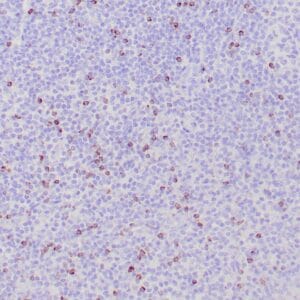
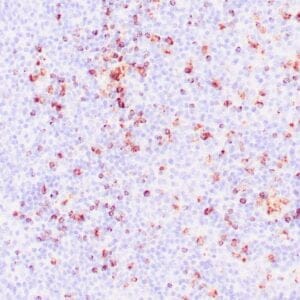
Reviews
There are no reviews yet.